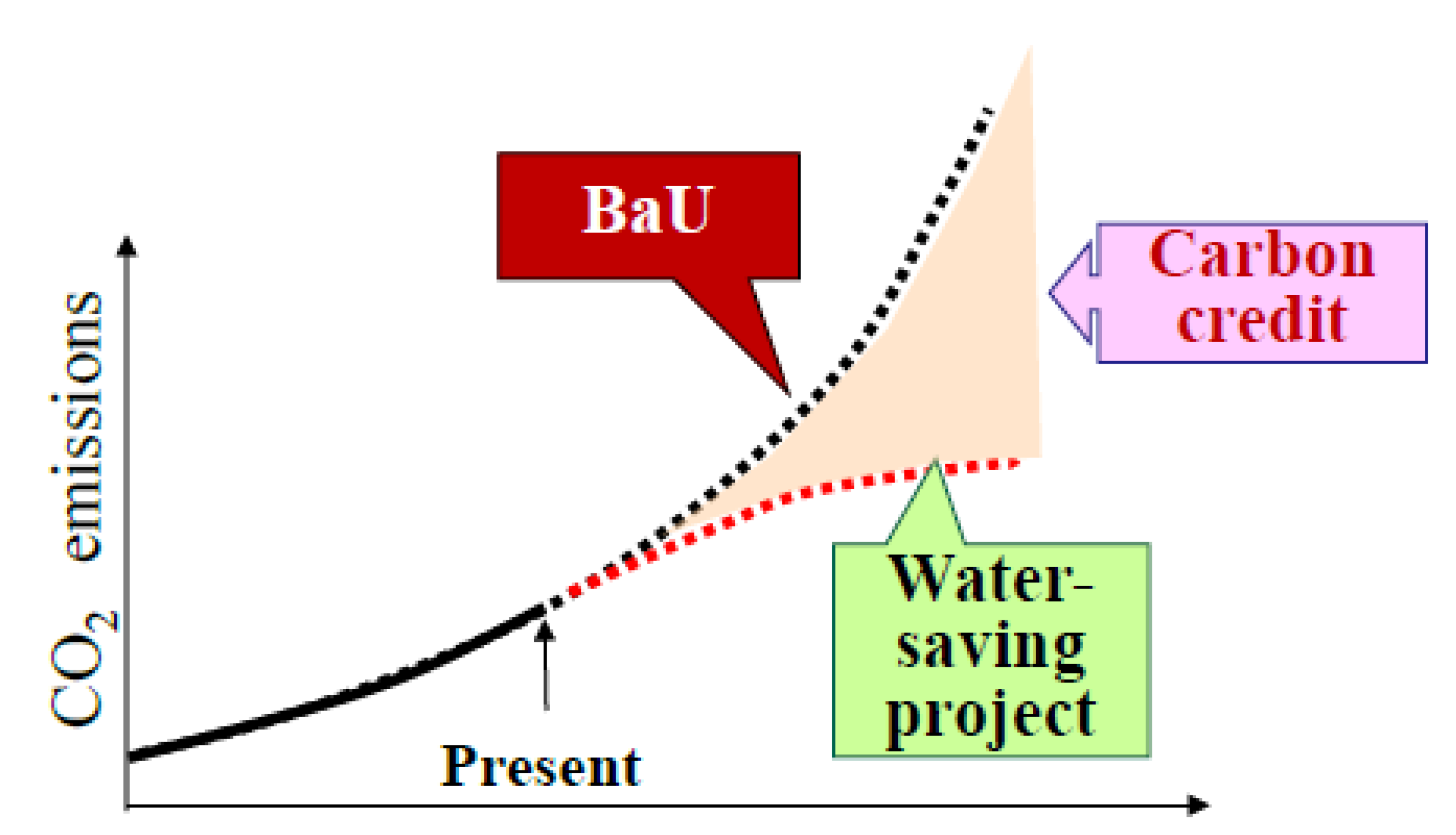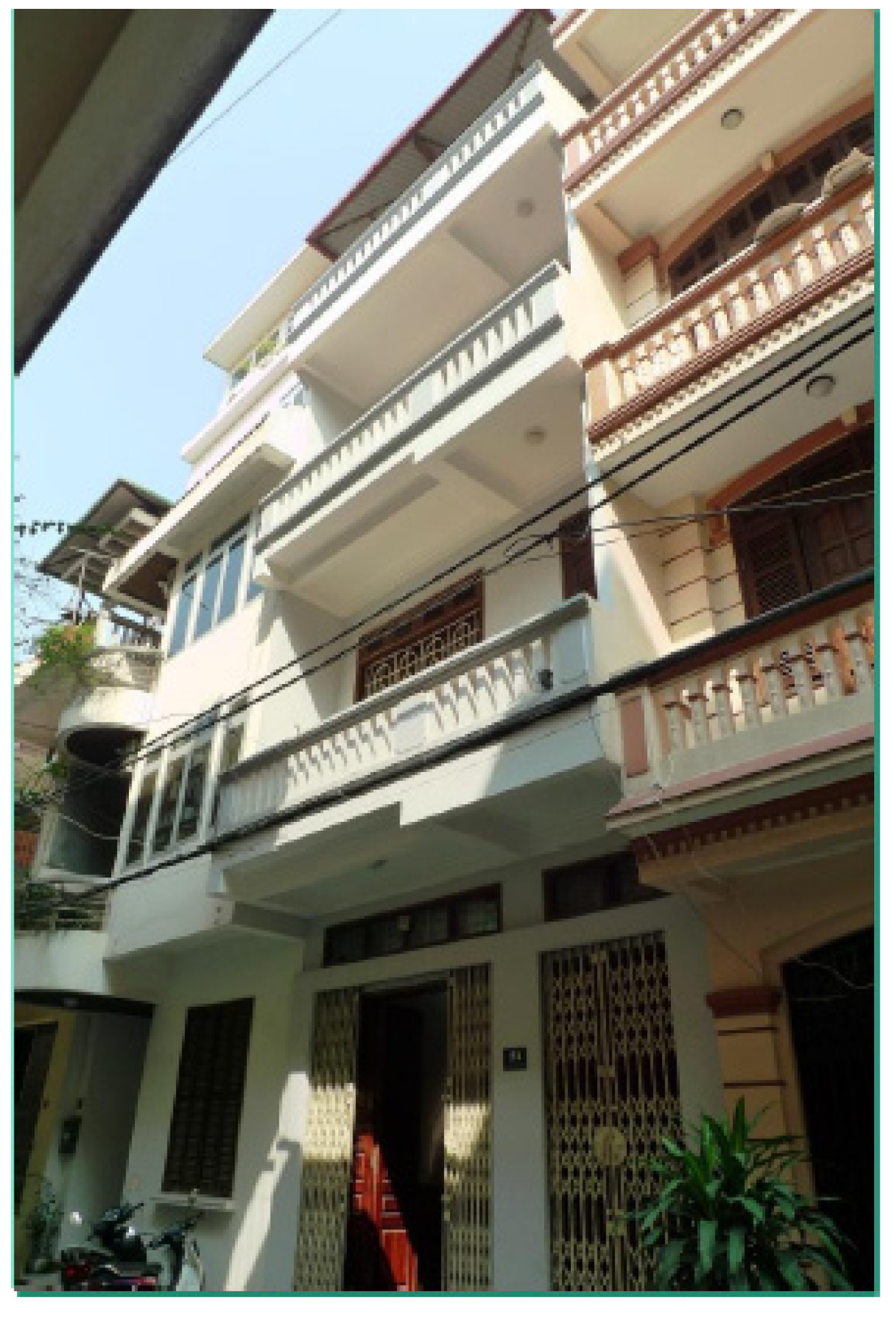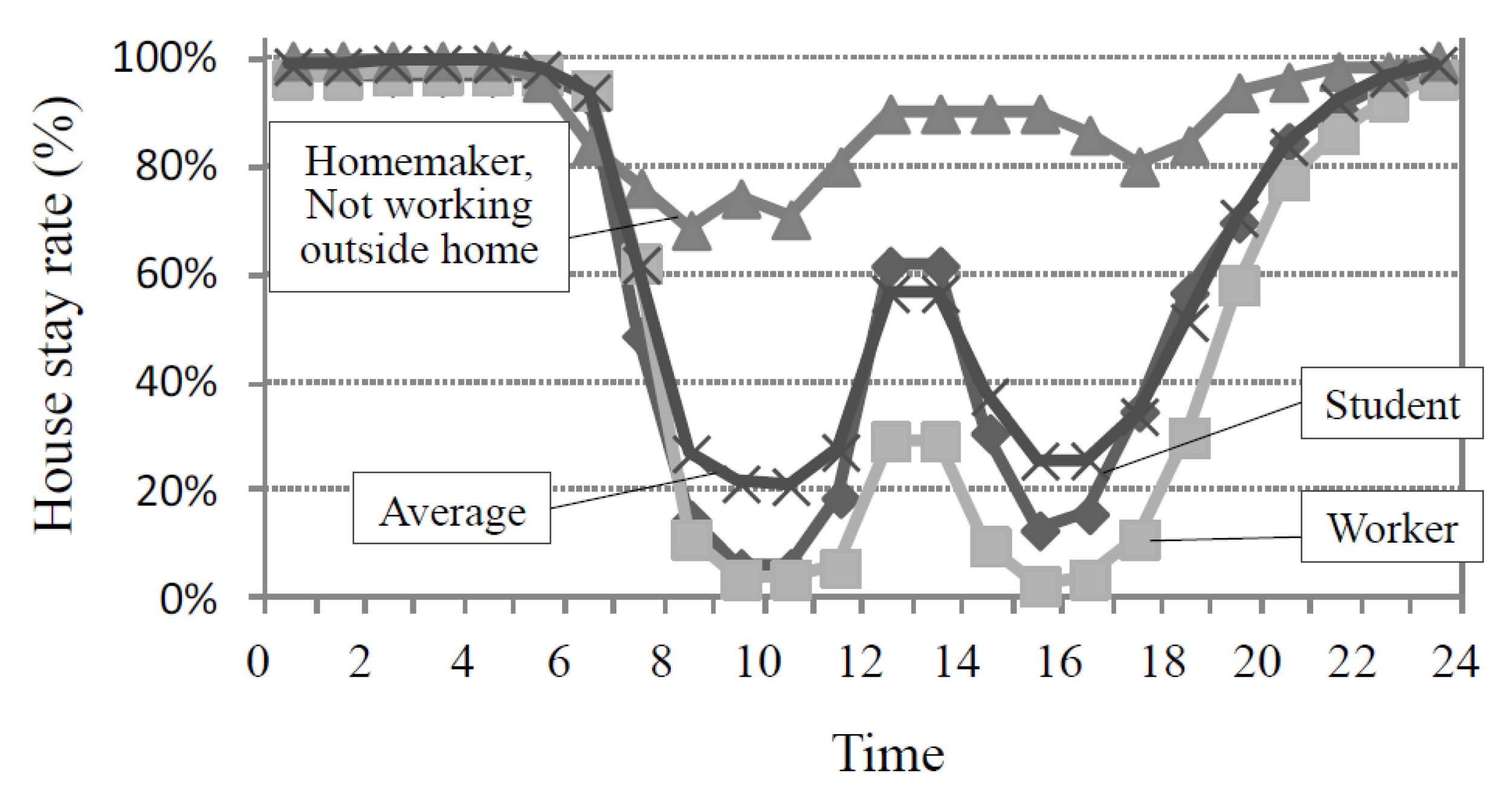3.1. Current Status and Problems of Water Infrastructure in Vietnam
Urbanization has advanced rapidly in Vietnam, and four of its cities have populations of more than one million. In those cities, although waterworks are developing, sewage systems are less developed [
8]. Overall, infrastructure development is not keeping pace with the expansion of cities, and there are many regions where a 24-h water supply does not exist. Also, due to the high rate of water leakage, the pressure in waterworks is set to a low value. Therefore, as shown in
Figure 2, it was found that residents were installing water tanks to secure a ready supply of domestic water.
Figure 2.
Example of water supply system in a Vietnamese house.
Figure 2.
Example of water supply system in a Vietnamese house.
The energy required for waterworks and sewer systems in Vietnam was analyzed by setting boundaries equivalent to the analysis of the system in Japan [
3,
6]. It was evaluated as energy consumption per unit of water, and calculated by dividing the total sum of energy consumption in all water supply and sewage facilities in Hanoi and Ho Chi Minh Cities by the total amount of treated water (see
Table 2). Rapid sand filtering is employed in waterworks, and the activated sludge method is employed in the sewage systems. The system configurations are not much different from those in Japan, and the energy consumption rate of water is within the range of the rate distribution of all facilities in Japan and, therefore, the calculated result was determined as appropriate.
Table 2.
Energy consumption rate of water in Vietnam.
Table 2.
Energy consumption rate of water in Vietnam.
| Process | Energy Consumption Rate of Water (MJ/m3) |
|---|
| Waterworks system | 1.44 |
| Sewer system | 1.05 |
| Water supply system in a house | 1.99 |
The energy consumption rate of water derived from water pumps in detached houses was also calculated (see
Table 2). The annual electricity consumption per capita in Vietnam is around 872 kw·h (one-eighth that of Japan) [
9], and energy consumption by water pumps accounts for about 3% of this figure.
3.2. Characteristics of Residents and Current and Future Situation Regarding Water Use Equipment
To study the potential of environmental load reduction by introducing water-saving toilets and showers, the performance of equipment used and the behavior of equipment use were surveyed in two cities: Ho Chi Minh City, where there are only dry and rainy seasons; and Hanoi City, where there are four seasons. There are about 21 million people in Vietnam, and 99% of them live in detached houses, only 230,000 (4% of residents in city areas) people live in collective housing, such as apartments in the inner city area [
10]. Accordingly, detached houses were selected as the research target.
Figure 3 and
Figure 4 show an example of water-related equipment in one of the houses we visited. Many residences in Hanoi and Ho Chi Minh City are like the one shown in the photograph: the building structure has a narrow frontage, great depth, and three floors. All surveyed residences had a toilet and shower room on each floor. According to the interview results, most Vietnamese families in large cities have two wage earners, and grandparents often live in the house to support in child-raising. As each generation uses one floor, it is typical for them to install a toilet/shower room on each floor. The average household size is 4.1 persons/household in Ho Chi Minh City, and considering that young, single people are coming into the large city, it appears that the average household size is large [
11].
Figure 3.
Outside view of the residence visited in Ho Chi Minh City, Vietnam.
Figure 3.
Outside view of the residence visited in Ho Chi Minh City, Vietnam.
Figure 4.
Photograph of a washroom in the residence.
Figure 4.
Photograph of a washroom in the residence.
All the toilets surveyed were Western-style, flushing toilets. All the residences had showers.
Table 3 and
Table 4 show the average performance of the toilets and the result of elimination behavior. The details for the calculation were shown in the previous paper [
12]. The results of preliminary survey and modeling of Japan and China are included. Although the daily number of times of using the toilet was similar in Japan, China, and Vietnam, which is 7–8 times per day, there was a slight difference in the number of times using and flushing the toilet at home. The number of times the toilet was used in the house was extracted from the 24-h data, using the house stay rate data in
Figure 5. Vietnamese family members stay home longer than family members do in Japan, as many company employees go home for lunch, and schools have a double system of morning/afternoon (see
Figure 5), and this is reflected in household toilet usage. Regarding toilet equipment performance, the amount of water in a flush is much less than the average toilet in Japan. It is thought that this is because many Vietnamese households use a bidet-type water nozzle for post-excretion cleaning purposes instead of using toilet paper. Thus, the waste volume in a toilet and the required flushing water in Vietnam are smaller than those of Japan. People do not dispose of toilet paper in toilets in China, either.
Table 3.
Comparison of toileting behavior in Vietnam, Japan and China (number/capita/day).
Table 3.
Comparison of toileting behavior in Vietnam, Japan and China (number/capita/day).
| Toileting Behavior | Vietnam | Japan [13] | China [14] |
|---|
| Number of eliminations | Excrement | 1.1 | 1.1 | 1.3 |
| Urine | 6.1 | 5.4 | 6.7 |
| Total | 7.2 | 6.5 | 8.0 |
| Number of toilet flushes at home | Full flush | 2.1 | 2.1 | 1.8 |
| Half flush | 4.8 | 2.6 | 4.3 |
| Total | 6.9 | 4.7 | 6.1 |
Table 4.
Typical toilet bowl used in Vietnam, Japan and China.
Figure 5.
Time spent at home in Vietnam by occupation (weekdays).
Figure 5.
Time spent at home in Vietnam by occupation (weekdays).
Table 5 shows the flow rates of the showerhead being used, and
Table 6 shows the number of times and length of time using the shower. Showering behavior was affected by latitude and thus the number of showers taken in the tropical city of Ho Chi Minh City was higher than in Hanoi. The water heater ownership rate was 90% in Hanoi and 68% in Ho Chi Minh City, based on surveyed residents and it was learned that taking a hot shower has become fairly popular for many families. The most common type of water heater varies between the north and south. Instantaneous electric water heaters were common in Ho Chi Minh City, while hot-water storage electric heaters were common in Hanoi City. The heaters are shown in
Table 7. According to distributors, storage heaters are selected in Hanoi because the tap water temperature is low in Hanoi City during winter and thus instantaneous heaters do not have the capability to warm water to a suitable temperature.
Table 5.
Typical showerhead used in Vietnam, Japan and China.
Table 6.
Shower usage model in Vietnam.
Table 6.
Shower usage model in Vietnam.
| Showering Behavior | Hanoi City | Ho Chi Minh City |
|---|
| Number of showers per week | 6.8 | 7.9 |
| Shower duration time (min.) | 10.1 | 7.6 |
| Shower temperature (°C) | 36.3 |
Table 7.
Water heater performance used in Vietnam.
Table 7.
Water heater performance used in Vietnam.
| Item | Instantaneous Electric Water Heater | Storage Electric Water Heater |
|---|
| Appearance | ![Water 07 02516 i009]() | ![Water 07 02516 i010]() |
| Power consumption (W) | 4500 | 2500 |
| Max. supply temperature (°C) | 40 | 60 |
| Storage capacity (L) | 0 | 10–30 |
Also, based on interviews about shower use during the survey in Ho Chi Minh City, most respondents said that they could not return to taking cold showers once having started taking hot showers. It is easy to assume that, with future economic growth in Vietnam, water heaters for showers will become even more popular in the near future.
3.3. CO2 Reduction Potential of Water Saving
The potential for reducing CO
2 emissions by popularizing water-saving equipment was evaluated. First, the CO
2 emission factor of water was determined based on the data for energy consumption rate, shown in
Table 2, and CO
2 emission factors of used energies, such as electricity. The calculated result is shown in
Table 8.
Table 8.
CO2 emission factor of water in Vietnam.
Table 8.
CO2 emission factor of water in Vietnam.
| Process | Emission Factor (kg-CO2/m3) |
|---|
| Waterworks system | 0.23 |
| Sewer system | 0.16 |
| Water supply system in a house | 0.32 |
The performance of water-saving toilets and showers to be introduced to Vietnam is shown in
Table 5 and
Table 6. Although development of the water infrastructure is insufficient currently, in the future, it is expected that development of the water infrastructure will advance rapidly with the support of Official Development Assistance from Japan and other countries. It is also assumed that an improvement in living standards will rapidly increase energy consumption resulting from hot water supply for showers and so on. Accordingly, assuming a near-future society where water infrastructures have developed and hot showers are common, the potential for reducing CO
2 emissions by water saving was calculated.
Table 9 shows the results, along with the CO
2 reduction potential by water saving, as calculated for Japan and China.
Table 9.
Contribution potential of water saving in Vietnam, Japan and China.
Table 9.
Contribution potential of water saving in Vietnam, Japan and China.
| Item | Vietnam | Japan | China |
|---|
| Energy consumption rate of water (kWh/m3) | 0.66 | 0.85 | 1.32 |
| CO2 emission factor of electricity (kg-CO2/kWh) | 0.58 | 0.41 | 0.84 |
| CO2 emission factor of water (kg-CO2/m3) | 0.39 | 0.44 | 1.11 |
| CO2 reduction potential by water saving (% ratio to whole emission) | 8.8 | 1.0 | 1.8 |
Research that relates to city water consumption and energy has been carried out in advanced nations [
3,
15,
16,
17]. This research was influenced by the examination of water saving in cities where the waterworks and sewerage systems were already developed. According to these results, the widespread adoption of water-saving equipment has the potential to reduce CO
2 emissions by 1% in Japan and Taiwan. Contribution of water saving in Vietnam was estimated to reduce CO
2 emissions by 8%. Since the energy consumption of Vietnam is still small, this greatly influences the contribution of water saving.
The Vietnam National Green Growth Strategy was announced in September 2012, and actions against global warming are being promoted. It is possible that the popularization of water-saving equipment will become a policy that contributes to green growth.




















